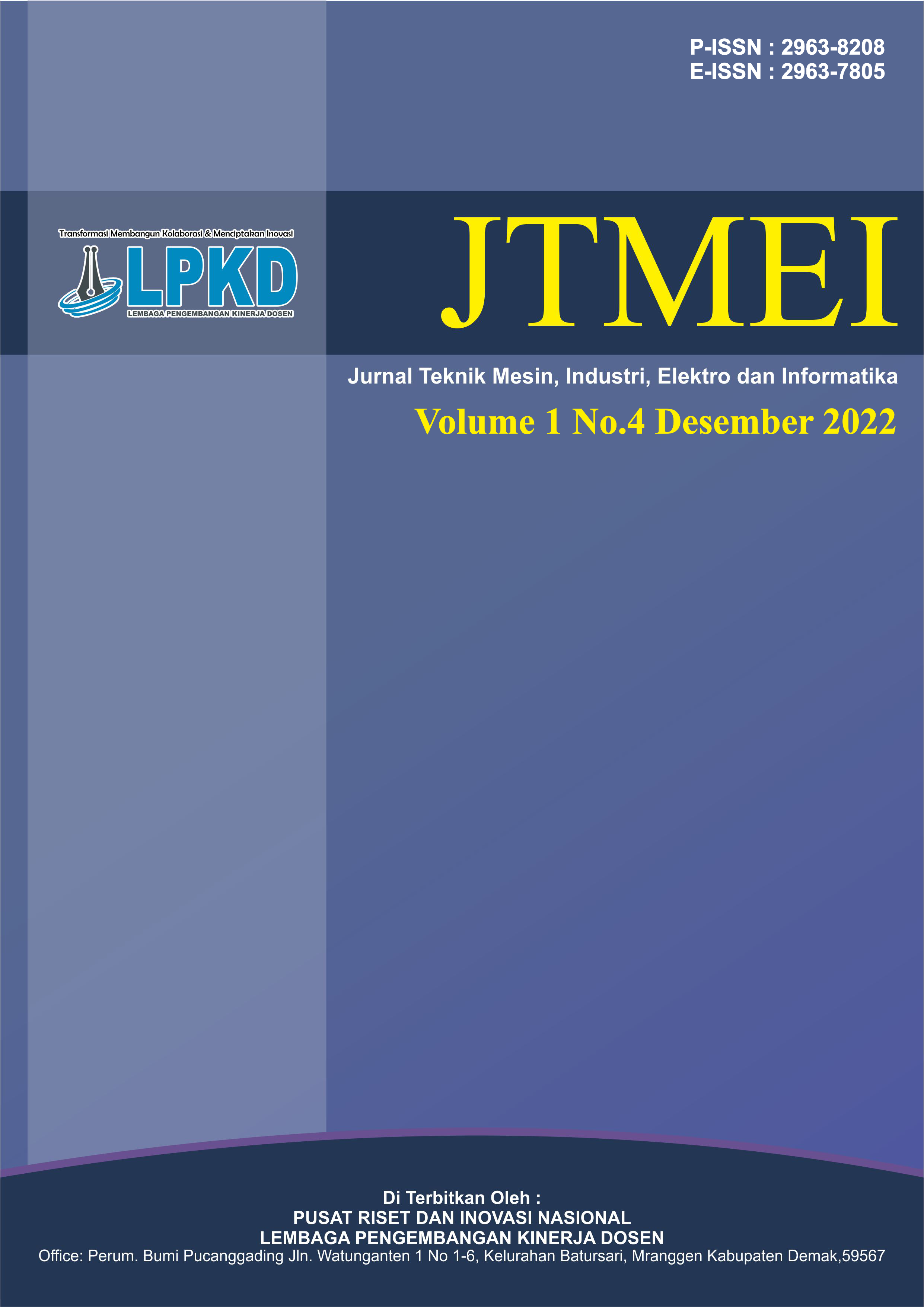Identifikasi Pengembangan Digital Supply Chain pada Industri Pengolahan Sampah
DOI:
https://doi.org/10.55606/jtmei.v1i4.671Keywords:
digital supply chain, supply chain performance, waste processingAbstract
Technology developments in the era of the industrial revolution 4.0 provide many opportunities to improve supply chain performance and performance. The existence of the waste processing industry as a business has prospects for development, given the large amount of waste generated by the community and the need for several processed products. PT A reduced the amount of garbage that accumulates in the final disposal site (TPA) by reprocessing the waste produced by the community. The existence of waste banks, government agencies, hotels, zoos, and Islamic boarding schools is one of the sources of waste that is processed for waste products. This paper seeks to develop the concept of a digital supply chain by adopting the supply chain model run by PT A. The initial identification presented in this paper can result in several technology identifications that need to be prioritized in implementing relevant technologies in the industry. The expected impact of this implementation is an increase in supply chain performance
Downloads
References
Abernathy, F. H., Dunlop, J. T., Hammond, J. H., & Weil, D. (2000). Retailing and supply chains in the information age. Technology in Society, 22(1). https://doi.org/10.1016/S0160-791X(99)00039-1
Ageron, B., Bentahar, O., & Gunasekaran, A. (2020). Digital supply chain: challenges and future directions. In Supply Chain Forum (Vol. 21, Issue 3). https://doi.org/10.1080/16258312.2020.1816361
Büyüközkan, G. (2018). Digital Supply Chain: Literature review and a proposed framework for future research. Computers in Industry, 97, 157–177. https://doi.org/10.1016/j.compind.2018.02.010
Cheng, C. H., Kuo, Y. H., Lam, H., & Petering, M. (2021). Real-time location-positioning technologies for managing cart operations at a distribution facility. Applied Sciences (Switzerland), 11(9). https://doi.org/10.3390/app11094049
Dixit, V. K., Malviya, R. K., & Pandey, S. (2021). Modelling the digital supply chain enablers using tism and micmac approach. Journal of Engineering Research (Kuwait), 2021. https://doi.org/10.36909/jer.ICIPPSD.15537
Feng, Q., & Shanthikumar, J. G. (2018). How Research in Production and Operations Management May Evolve in the Era of Big Data. SSRN Electronic Journal. https://doi.org/10.2139/ssrn.3089257
Hara, L., Guirguis, R., Hummel, K., & Villanueva, M. (2017). More than bar codes: Integrating global standards-based bar code technology into national health information systems in Ethiopia and Pakistan to increase end-to-end supply chain visibility. Global Health Science and Practice, 5(4). https://doi.org/10.9745/GHSP-D-16-00350
Kamble, S. S., Gunasekaran, A., Parekh, H., Mani, V., Belhadi, A., & Sharma, R. (2022). Digital twin for sustainable manufacturing supply chains: Current trends, future perspectives, and an implementation framework. Technological Forecasting and Social Change, 176. https://doi.org/10.1016/j.techfore.2021.121448
Luo, S., & Choi, T. M. (2022). Operational Research for Technology-Driven Supply Chains in the Industry 4.0 Era: Recent Development and Future Studies. Asia-Pacific Journal of Operational Research, 39(1). https://doi.org/10.1142/S0217595920400217
Manthou, V., & Vlachopoulou, M. (2001). Bar-code technology for inventory and marketing management systems: A model for its development and implementation. International Journal of Production Economics, 71(1–3). https://doi.org/10.1016/S0925-5273(00)00115-8
Manuel Maqueira, J., Moyano-Fuentes, J., & Bruque, S. (2019). Drivers and consequences of an innovative technology assimilation in the supply chain: cloud computing and supply chain integration. International Journal of Production Research, 57(7). https://doi.org/10.1080/00207543.2018.1530473
Mukherjee, S., Chittipaka, V., Baral, M. M., & Srivastava, S. C. (2022). Integrating the Challenges of Cloud Computing in Supply Chain Management. Lecture Notes in Mechanical Engineering. https://doi.org/10.1007/978-981-16-5281-3_33
Nasiri, M., Ukko, J., Saunila, M., & Rantala, T. (2020). Managing the digital supply chain: The role of smart technologies. Technovation, 96–97. https://doi.org/10.1016/j.technovation.2020.102121
Núñez-Merino, M., Maqueira-Marín, J. M., Moyano-Fuentes, J., & Martínez-Jurado, P. J. (2020). Information and digital technologies of Industry 4.0 and Lean supply chain management: a systematic literature review. International Journal of Production Research, 58(16). https://doi.org/10.1080/00207543.2020.1743896
Omitola, T., & Wills, G. (2018). Towards Mapping the security Challenges of the Internet of Things (IoT) supply Chain. Procedia Computer Science, 126. https://doi.org/10.1016/j.procS.2018.07.278
Patrucco, A., Moretto, A., Trabucchi, D., & Golini, R. (2022). How Do Industry 4.0 Technologies Boost Collaborations in Buyer-Supplier Relationships? Research Technology Management, 65(1). https://doi.org/10.1080/08956308.2021.1999131
Schniederjans, D GSchniederjans, D. G. (2020). Supply chain digitisation trends: An integration of knowledge management. International Journal of Production Economics, 220. https://doi.org/10.1016/j.ijpe.2019.07.012. (2020). Supply chain digitisation trends: An integration of knowledge management. International Journal of Production Economics, 220. https://doi.org/10.1016/j.ijpe.2019.07.012
Tserng, H. P., Dzeng, R. J., Lin, Y. C., & Lin, S. T. (2005). Mobile construction supply chain management using PDA and Bar Codes. Computer-Aided Civil and Infrastructure Engineering, 20(4). https://doi.org/10.1111/j.1467-8667.2005.00391
Vazquez-Martinez, G. A., Gonzalez-Compean, J. L., Sosa-Sosa, V. J., Morales-Sandoval, M., & Perez, J. C. (2018). CloudChain: A novel distribution model for digital products based on supply chain principles. International Journal of Information Management, 39. https://doi.org/10.1016/j.ijinfomgt.2017.12.006
Widya, C., Supriyani, N., Andianti, R., & Zulkifli, M. (2021). Statistik Lingkungan Hidup Indonesia 2021 Energi dan Lingkungan. In Badan Pusat Statistik.
Xu, G., Li, M., Chen, C. H., & Wei, Y. (2018). Cloud asset-enabled integrated IoT platform for lean prefabricated construction. Automation in Construction, 93. https://doi.org/10.1016/j.autcon.2018.05.012
Yoo, Y., Henfridsson, O., & Lyytinen, K. (2010). The new organizing logic of digital innovation: An agenda for information systems research. Information Systems Research, 21(4). https://doi.org/10.1287/isre.1100.0322








